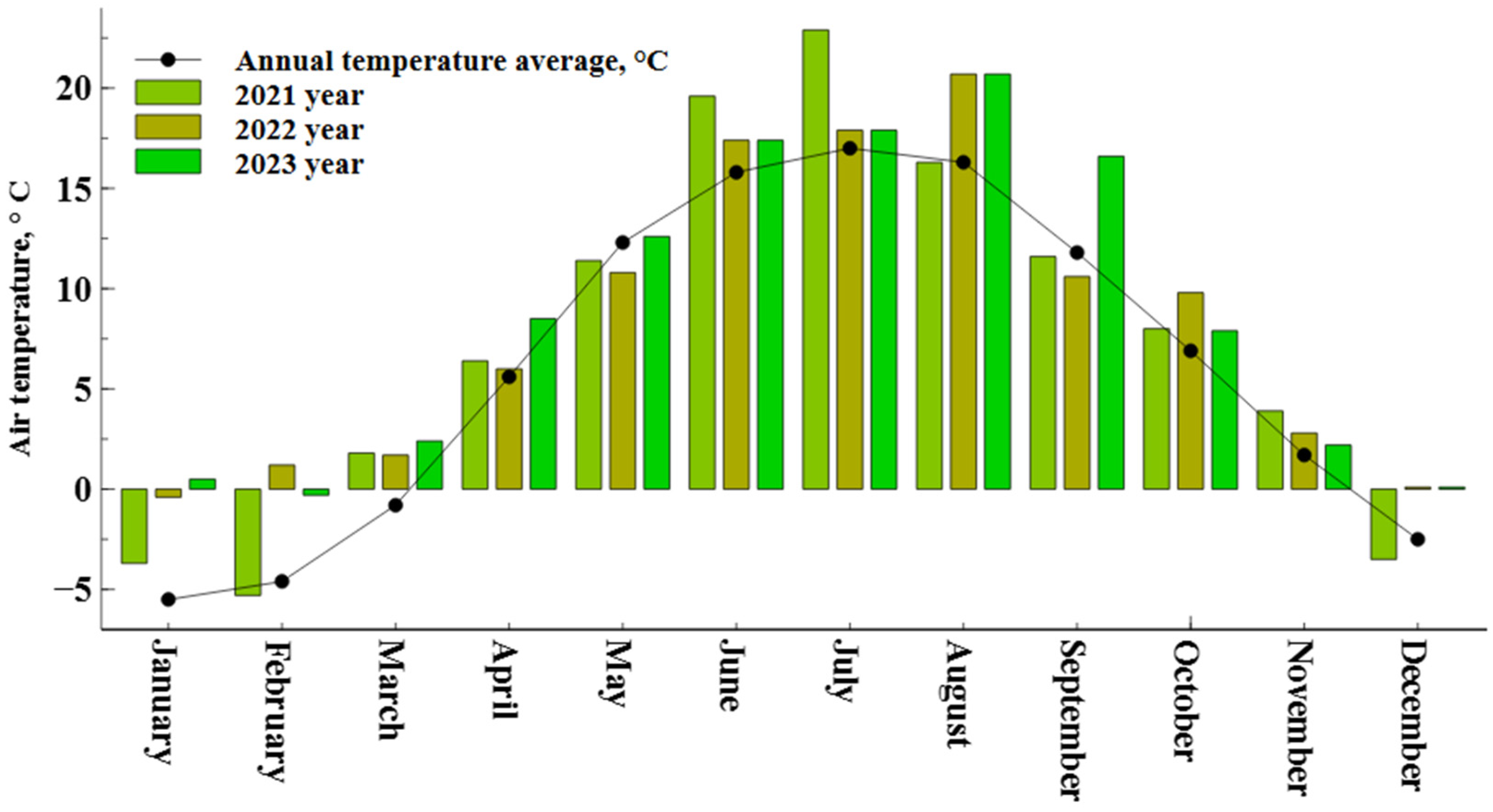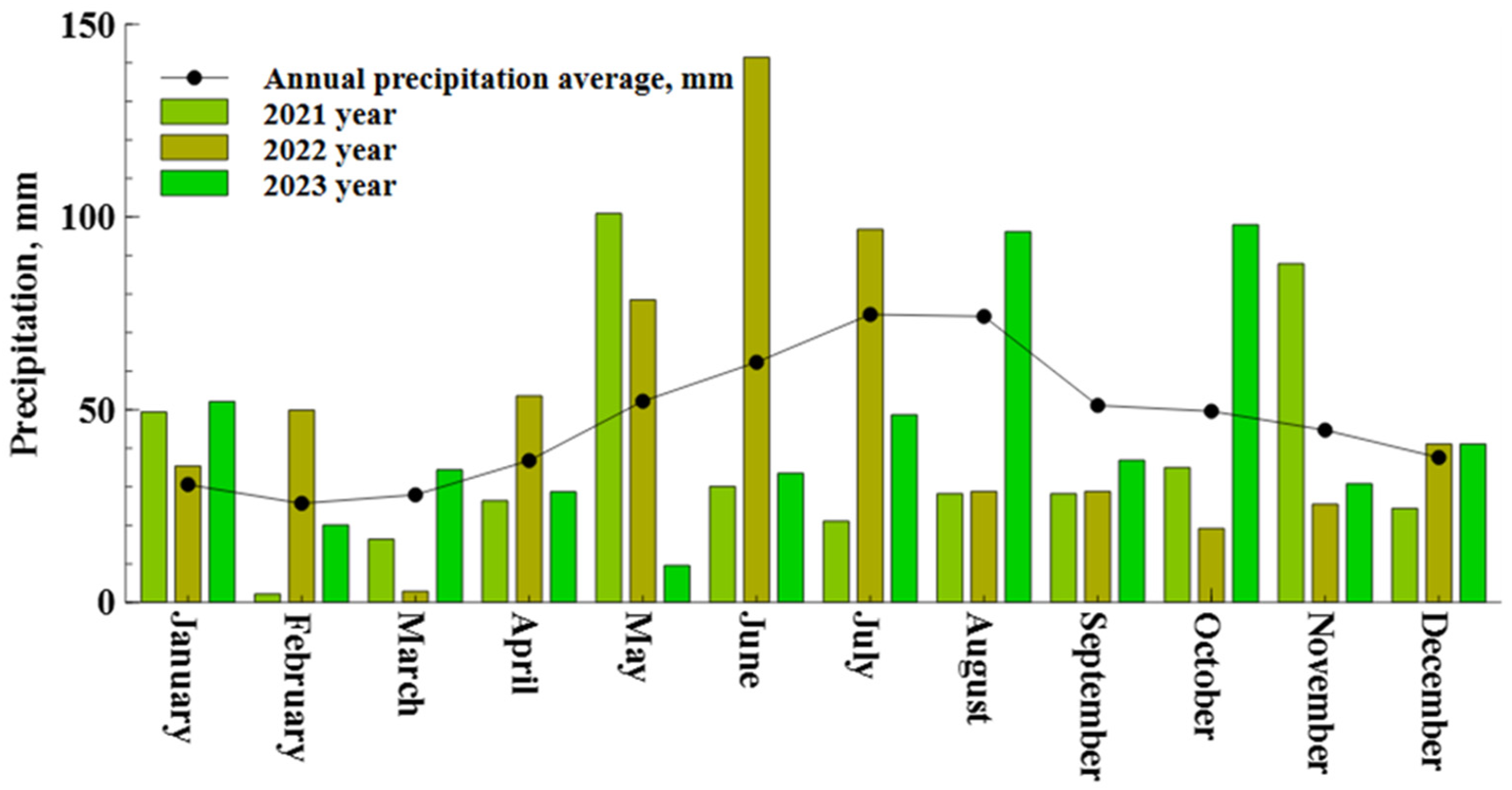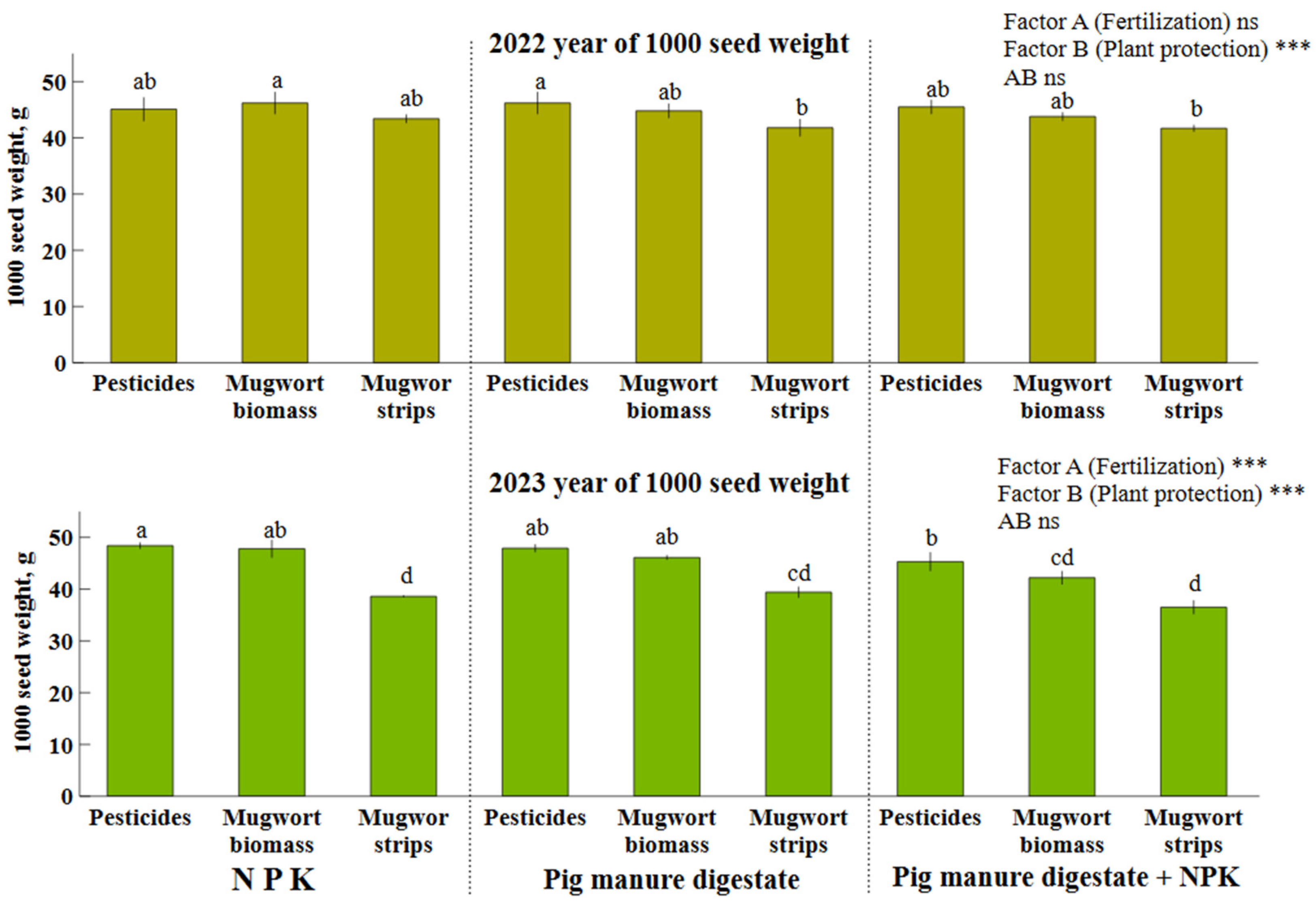Influence of Artemisia dubia Wall and Pig Manual Digestate on Winter Wheat Productivity and Grain Quality
Abstract
:1. Introduction
2. Materials and Methods
2.1. Field Experiment
2.2. Meteorological Conditions
2.3. Measurement of Traits
2.3.1. Wheat Grains Yield
2.3.2. Weight of 1000 Grains of Wheat
2.3.3. Protein, Gluten, Starch, Sedimentation of Grains
2.4. Statistical Analysis
3. Results and Discussion
3.1. Grain Yield
3.2. 1000-Seed Weight
3.3. Protein, Gluten, Starch, Sedimentation of Grains
4. Conclusions
Author Contributions
Funding
Institutional Review Board Statement
Data Availability Statement
Conflicts of Interest
References
- He, H.; Peng, M.; Lu, W.; Hou, Z.; Li, J. Commercial Organic Fertilizer Substitution Increases Wheat Yield by Improving Soil Quality. Sci. Total Environ. 2022, 851, 158132. [Google Scholar] [CrossRef] [PubMed]
- Bi, H.; Miao, J.; He, J.; Chen, Q.; Qian, J.; Li, H.; Xu, Y.; Ma, D.; Zhao, Y.; Tian, X.; et al. Characterization of the Wheat Heat Shock Factor TaHsfA2e-5D Conferring Heat and Drought Tolerance in Arabidopsis. Int. J. Mol. Sci. 2022, 23, 2784. [Google Scholar] [CrossRef] [PubMed]
- Würschum, T.; Leiser, W.L.; Kazman, E.; Longin, C.F.H. Genetic Control of Protein Content and Sedimentation Volume in European Winter Wheat Cultivars. Theor. Appl. Genet. 2016, 129, 1685–1696. [Google Scholar] [CrossRef] [PubMed]
- Yin, Z.; Hu, J.; Zhang, J.; Zhou, X.; Li, L.; Wu, J. Temporal and Spatial Evolution of Global Major Grain Trade Patterns. J. Integr. Agric. 2024, 23, 1075–1086. [Google Scholar] [CrossRef]
- Agriculture—Oficialiosios Statistikos Portalas. Available online: https://osp.stat.gov.lt/ (accessed on 22 August 2024).
- Mitura, K.; Cacak-Pietrzak, G.; Feledyn-Szewczyk, B.; Szablewski, T.; Studnicki, M. Yield and Grain Quality of Common Wheat (Triticum aestivum L.) Depending on the Different Farming Systems (Organic vs. Integrated vs. Conventional). Plants 2023, 12, 1022. [Google Scholar] [CrossRef]
- Nuttall, J.G.; O’Leary, G.J.; Panozzo, J.F.; Walker, C.K.; Barlow, K.M.; Fitzgerald, G.J. Models of Grain Quality in Wheat—A Review. Field Crops Res. 2017, 202, 136–145. [Google Scholar] [CrossRef]
- Mariem, S.B.; González-Torralba, J.; Collar, C.; Aranjuelo, I.; Morales, F. Durum Wheat Grain Yield and Quality under Low and High Nitrogen Conditions: Insights into Natural Variation in Low-and High-Yielding Genotypes. Plants 2020, 9, 1636. [Google Scholar] [CrossRef]
- Kryževičienė, A.; Šarūnaitė, L.; Stukonis, V.; Dabkevičius, Z.; Kadžiulienė, Ž. Daugiamečių Kiečių (Artemisia vulgaris L. Ir Artemisia dubia Wall.) Potencialo Biokuro Gamybai Įvertinimas; LMA leidykla: Vilnius, Lithuania, 2010. [Google Scholar]
- Titova, J.; Baltrėnaitė, E. Physical and Chemical Properties of Biochar Produced from Sewage Sludge Compost and Plants Biomass, Fertilized with That Compost, Important for Soil Improvement. Waste Biomass Valorization 2021, 12, 3781–3800. [Google Scholar] [CrossRef]
- Bakšinskaitė, A.; Tilvikiene, V.; Barčauskaitė, K.; Feizienė, D. Potential of Artemisia Dubia Wall Biomass for Natural Crop Protection. Plants 2023, 12, 3750. [Google Scholar] [CrossRef]
- Bakšinskaitė, A.; Tilvikienė, V.; Doyeni, M.O. Biomass Yield and Biofiber Properties of Select Industrial Fiber Crops in Lithuania. Agron. J. 2022, 114, 3129–3140. [Google Scholar] [CrossRef]
- Pouresmaeil, M.; Nojadeh, M.S.; Movafeghi, A.; Maggi, F. Exploring the Bio-Control Efficacy of Artemisia Fragrans Essential Oil on the Perennial Weed Convolvulus Arvensis: Inhibitory Effects on the Photosynthetic Machinery and Induction of Oxidative Stress. Ind. Crops Prod. 2020, 155, 112785. [Google Scholar] [CrossRef]
- R Core Team. R: A Language and Environment for Statistical Computing; R Foundation for Statistical Computing: Vienna, Austria, 2022; Available online: https://www.scirp.org/(S(lz5mqp453ed%20snp55rrgjct55))/reference/referencespapers.aspx?referenceid=3456808 (accessed on 23 October 2023).
- Xie, Q.; Sparkes, D.L. Dissecting the Trade-off of Grain Number and Size in Wheat. Planta 2021, 254, 3. [Google Scholar] [CrossRef]
- Wang, Y.; Zhu, Y.; Zhang, S.; Wang, Y. What Could Promote Farmers to Replace Chemical Fertilizers with Organic Fertilizers? J. Clean. Prod. 2018, 199, 882–890. [Google Scholar] [CrossRef]
- Duan, N.; Khoshnevisan, B.; Lin, C.; Liu, Z.; Liu, H. Life Cycle Assessment of Anaerobic Digestion of Pig Manure Coupled with Different Digestate Treatment Technologies. Environ. Int. 2020, 137, 105522. [Google Scholar] [CrossRef] [PubMed]
- Du, X.; Gao, Z.; Sun, X.; Bian, D.; Ren, J.; Yan, P.; Cui, Y. Increasing Temperature during Early Spring Increases Winter Wheat Grain Yield by Advancing Phenology and Mitigating Leaf Senescence. Sci. Total Environ. 2022, 812, 152557. [Google Scholar] [CrossRef] [PubMed]
- Dias, A.S.; Lidon, F.C. Evaluation of Grain Filling Rate and Duration in Bread and Durum Wheat, under Heat Stress after Anthesis. J. Agron. Crop Sci. 2009, 195, 137–147. [Google Scholar] [CrossRef]
- Thomas, C.L.; Acquah, G.E.; Whitmore, A.P.; McGrath, S.P.; Haefele, S.M. The Effect of Different Organic Fertilizers on Yield and Soil and Crop Nutrient Concentrations. Agronomy 2019, 9, 776. [Google Scholar] [CrossRef]
- Doyeni, M.O.; Stulpinaite, U.; Baksinskaite, A.; Suproniene, S.; Tilvikiene, V. The Effectiveness of Digestate Use for Fertilization in an Agricultural Cropping System. Plants 2021, 10, 1734. [Google Scholar] [CrossRef]
- Li, L.; Mao, Z.; Wang, P.; Cai, J.; Zhou, Q.; Zhong, Y.; Jiang, D.; Wang, X. Drought Priming Enhances Wheat Grain Starch and Protein Quality under Drought Stress during Grain Filling. J. Integr. Agric. 2024, in press. [CrossRef]
- Zareian, A.; Yari, L.; Hasani, F.; Ranjbar, G.H. Field Performance of Three Wheat (Triticum aestivum L.) Cultivars in Various Seed Sizes. World Appl. Sci. J. 2012, 16, 202–206. [Google Scholar]
- Ali, N.; Khan, M.N.; Ashraf, M.S.; Ijaz, S.; Saeed-ur-Rehman, H.; Abdullah, M.; Ahmad, N.; Akram, H.M.; Farooq, M. Influence of Different Organic Manures and Their Combinations on Productivity and Quality of Bread Wheat. J. Soil. Sci. Plant Nutr. 2020, 20, 1949–1960. [Google Scholar] [CrossRef]
- Zhong, C.; Zhang, Z.; Huang, M.; Li, Q.; Zhong, Y.; Wang, X.; Cai, J.; Dai, T.; Zhou, Q.; Jiang, D. Screening of Superior Wheat Lines under Nitrogen Regulation and Factors Affecting Grain Quality Improvement under High Yield. J. Cereal Sci. 2024, 118, 103958. [Google Scholar] [CrossRef]
- Zörb, C.; Ludewig, U.; Hawkesford, M.J. Perspective on Wheat Yield and Quality with Reduced Nitrogen Supply. Trends Plant Sci. 2018, 23, 1029–1037. [Google Scholar] [CrossRef] [PubMed]
- Zhang, L.; Wu, Z.; Zhou, J.; Zhou, L.; Lu, Y.; Xiang, Y.; Zhang, R.; Deng, Q.; Wu, W. Meta-Analysis of the Response of the Productivity of Different Crops to Parameters and Processes in Soil Nitrogen Cycle under Biochar Addition. Agronomy 2022, 12, 1857. [Google Scholar] [CrossRef]
- Cesevičienė, J.; Gorash, A.; Liatukas, Ž.; Armonienė, R.; Ruzgas, V.; Statkevičiūtė, G.; Jaškūnė, K.; Brazauskas, G. Grain Yield Performance and Quality Characteristics of Waxy and Non-Waxy Winter Wheat Cultivars under High and Low-Input Farming Systems. Plants 2022, 11, 882. [Google Scholar] [CrossRef]
- Kibkalo, I. Effectiveness of and Perspectives for the Sedimentation Analysis Method in Grain Quality Evaluation in Various Cereal Crops for Breeding Purposes. Plants 2022, 11, 1640. [Google Scholar] [CrossRef]
- Ceseviciene, J.; Slepetiene, A.; Leistrumaite, A.; Ruzgas, V.; Slepetys, J. Effects of Organic and Conventional Production Systems and Cultivars on the Technological Properties of Winter Wheat. J. Sci. Food Agric. 2012, 92, 2811–2818. [Google Scholar] [CrossRef]






Disclaimer/Publisher’s Note: The statements, opinions and data contained in all publications are solely those of the individual author(s) and contributor(s) and not of MDPI and/or the editor(s). MDPI and/or the editor(s) disclaim responsibility for any injury to people or property resulting from any ideas, methods, instructions or products referred to in the content. |
© 2024 by the authors. Licensee MDPI, Basel, Switzerland. This article is an open access article distributed under the terms and conditions of the Creative Commons Attribution (CC BY) license (https://creativecommons.org/licenses/by/4.0/).
Share and Cite
Baksinskaite, A.; Doyeni, M.O.; Tilvikiene, V. Influence of Artemisia dubia Wall and Pig Manual Digestate on Winter Wheat Productivity and Grain Quality. Agriculture 2024, 14, 1819. https://doi.org/10.3390/agriculture14101819
Baksinskaite A, Doyeni MO, Tilvikiene V. Influence of Artemisia dubia Wall and Pig Manual Digestate on Winter Wheat Productivity and Grain Quality. Agriculture. 2024; 14(10):1819. https://doi.org/10.3390/agriculture14101819
Chicago/Turabian StyleBaksinskaite, Ausra, Modupe Olufemi Doyeni, and Vita Tilvikiene. 2024. "Influence of Artemisia dubia Wall and Pig Manual Digestate on Winter Wheat Productivity and Grain Quality" Agriculture 14, no. 10: 1819. https://doi.org/10.3390/agriculture14101819
APA StyleBaksinskaite, A., Doyeni, M. O., & Tilvikiene, V. (2024). Influence of Artemisia dubia Wall and Pig Manual Digestate on Winter Wheat Productivity and Grain Quality. Agriculture, 14(10), 1819. https://doi.org/10.3390/agriculture14101819






